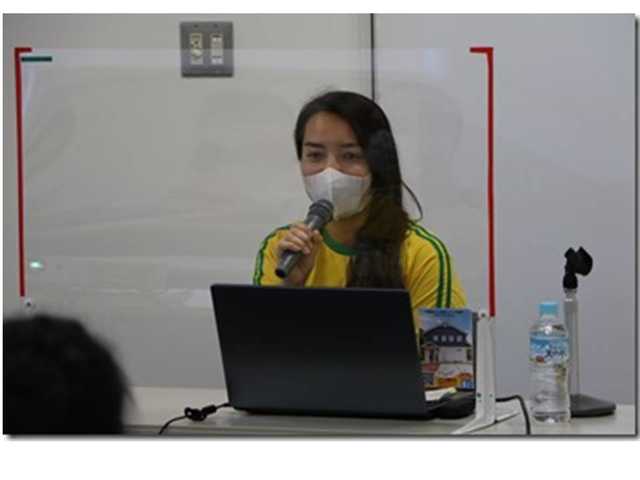 マンスリーイングリッシュサロンはコロナウィルス感染拡大により2020/3,5の2回を中止しました。
今回は感染防止対策を行った上で、ブラジル生まれで既に3年在住してみえるGabriela Kubagawaさんに英語で母国を語っていただきました。
ご用意いただいたパワーポイントに英語でスクリプトをいれていただいたのでそれを掲載させていただきます。 |
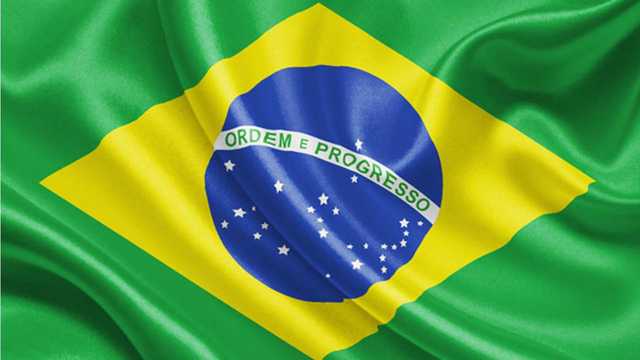 In Brazil we have kind of an issue about time. If a Brazilian invites you to a party or a barbecue and tells you it will start at 1 o’clock, it means that it will start around 2 o’clock or more.
We also have the bad habit of inviting people that we just met to visit us at home, without giving our address or even our phone number. It’s like “ok come home someday, bye!”
Of course, for officials or serious appointments, this is more rare, but it can also happen.
In Brazil it is very common to have two surnames. For example, my name is Gabriela Kubagawa Silva.
So Kubagawa is from my mother and Silva is from my father. And everyone calls me Gabriela or by my nickname Gabi, even people that don’t know me very well. For Brazilians it isn’t rude to call people by their first name or nickname. Some people can have more than three surnames. Silva, my last name, is the most common surname in Brazil, 1 among 40 people has it.
Ok, let’s get started!
|
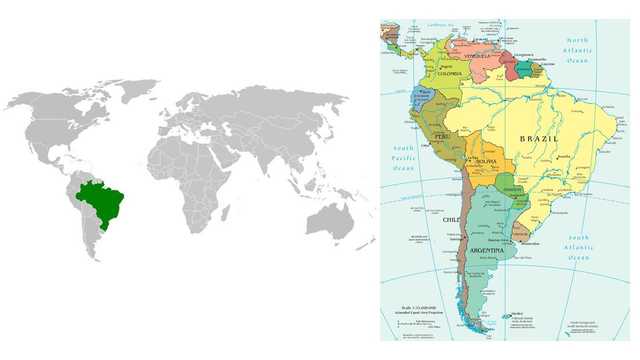 Brazil is located in South America, it is the opposite side of Japan in the globe. Around 25 hours of flight, not considering the stopovers.
It borders(land, river) with the Atlantic Ocean and with almost every country in South America, excepts Ecuador and Chile.
|
 Brazil was inhabited by numerous tribal nations prior to the arrival in 1500 (fifteen hundred) by Portugal.
This is the picture every history book has in it. Portuguese ships arriving and the naked indigenous looking from the beach.
It is estimated that around 6 million of indigenous were living around all Brazilian territory at the time. Today there are less than 1 million.
We became independent from Portugal in 1822.
Brazil is the largest country to have Portuguese as an official language and the only one in the Americas. It is very similar to Portuguese from Portugal, we can understand each other even though with different accent and vocabulary. And we can’t really understand Spanish, we just pretend it.
|
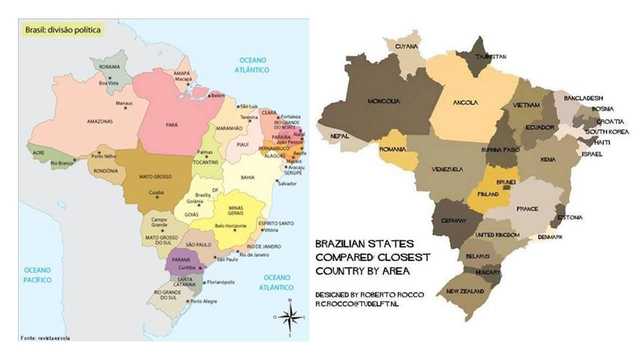 Brazil is the biggest country in Latin America and is divided into 26 states and the Federal District, where our capital Brasilia is located.
In the world it’s the 5th largest country by area and 6th most populous with around 209 million people.
I found this really interesting map, that compares the Brazilian states with other countries by area. So here, Amazonas State, where most part of Amazon Rainforest is located, has almost the same area as Mongolia. Rio de Janeiro has almost the same area as Denmark.
Just to have an idea about how big Brazil is. I mean, from Rio de Janeiro city to the capital, Brasilia, by car takes around 14 hours. From Porto Alegre, the capital of Rio Grande do Sul state, to Sao Luis, the capital of Maranhao, the distance is around 4000 km and it takes almost 60 hours. So, really big.
|
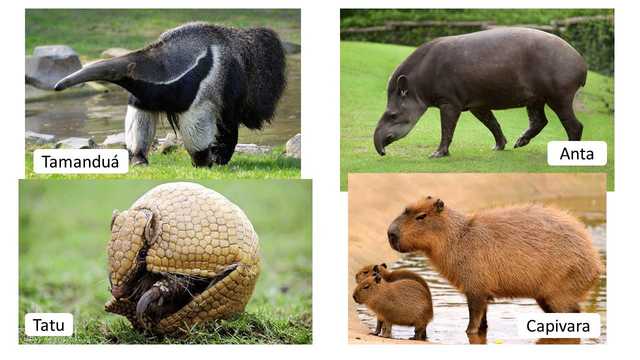 As a large country, there are a big variety of fauna and flora. Here are some examples of common animals we can find in Brazil.
Here is a Tamandua. It is a mammal that eats ants, this is why he has this long face. And a long tongue.
Here is a Tatu. Also a mammal that has this hard cover in his back and become a ball when feel threat.
This is an Anta. The biggest terrestrial mammal in Brazil.
And Capivara, the biggest rodent in the world. It is native of South America. The name comes from an indigenous language and means grass eater.
|
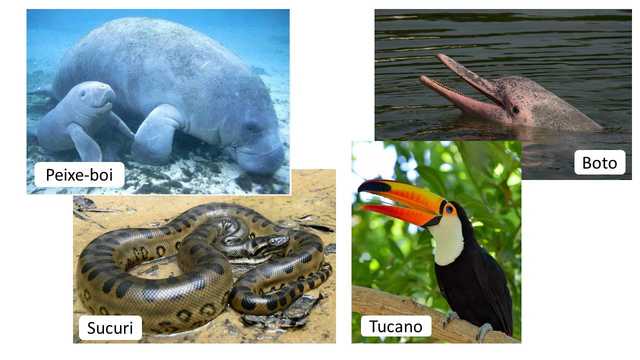 Here is a peixe-boi, the literal translation would be something like cow-fish. It is really big, can reach 300 kg and lives in the rivers.
This animal looks like a dolphin, but it is pink. Also lives in the river. It’s called boto.
Here is the feared Sucuri, it became famous with the name of Anaconda. Actually she doesn`t have poison. She is the largest snake in the world, but not the longest.
And this is a Tucano, a bird really impressive and beautiful. I had the opportunity to see a couple of Tucanos in the nature while walking in a park, it was amazing.
|
 Here is the money!
The Currency is Real/Reais (plural). Because of the Corona Virus situation plus the political mess going around there, R$1 is now around 20 yens.
In Brazil we pay a lot of taxes, but the thing is that the taxes don’t return to the population. The social inequality rate is really high.
Since 1994, the Brazilian banknotes have images of animals from the local fauna on the back. It is an effort to bring awareness to people about wild life preservation, but also to make the falsification harder.
|
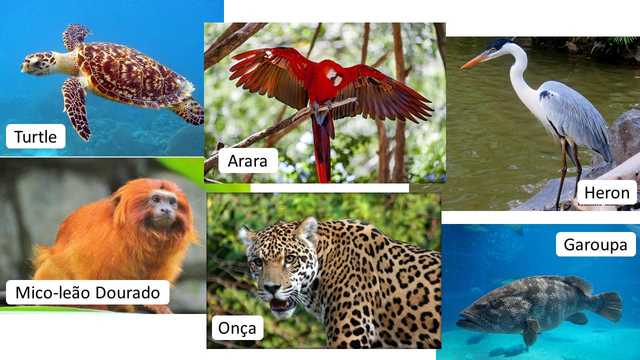 Here are the real animals printed in the banknotes.
|
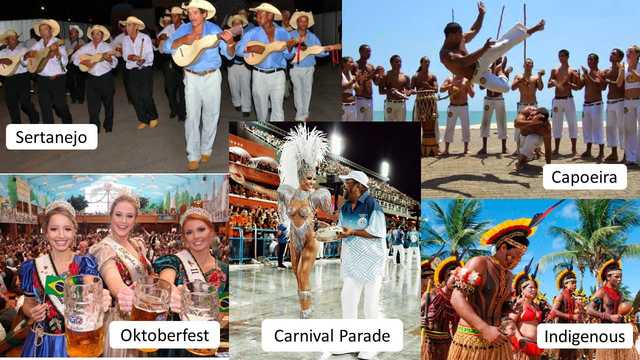 Brazil is one of the most multicultural and ethnically diverse nations, mainly due to over a century of mass immigration from around the world.
And also as result of the slave trade, around 5 million Africans were taken to Brazil as slaves, which makes Brazil the country that most received Africans slaves throughout history.
Then, when the slavery was abolished, Brazil suffer a lack of labor so a lot of immigrants mainly from Italy, Japan, German, Spain and Lebanon went to Brazil to work at coffee crops.
And this is how the Brazilian identity was built.
Here we can see men from the Midwest Region, great amount of farmers and where one of the most successful Brazilian music gender were born: Sertanejo
Here is people practicing Capoeira. It is a mix of dance and fight, created by the slaves. As they were punished if they fight between them, they created this dispute where the participants can`t touch each other.
Here is the queens of the Oktoberfest, in the South of Brazil. It is the second largest in the world, behind only the original one in Munich, Germany. Here is where we find the most part of blond people in Brazil.
Here is an example of how woman participate on the Samba Parade during the Carnival. This is a famous actress that has Japanese descendance. Her name is Sabrina Sato.
And here is an indigenous tribe from Amazonia during a celebration.
|
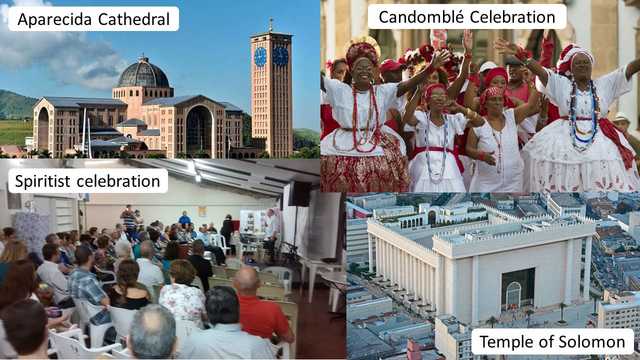 The diversity also appears in religion. Brazilians are mostly Christian, but there are a lot of different churches and congregations. Here are some examples of the four biggest religious beliefs and churches:
This is the Aparecida Catholic Cathedral. It is the second largest in the world, only smaller than St. Peter´s Basilica in the Vatican. Located in a small city in Sao Paulo state. Brazil is the country with the largest Catholic population in the world, representing almost 10% of Catholics worldwide, around 123 million.
These are priestess of candomble, an afro-brazilian religion, which derived from traditional African cults. Mostly practiced in the Northeast.
The Temple of Solomon is a replica of the one cited in the Bible and the world headquarters of the Universal Church of the Kingdom of God, an evangelic/gospel church. It is one of the most visited tourist spots in Brazil, surpassing the Christ the Redeemer and Pao de Acucar in Rio de Janeiro.
This is a Spiritist meeting. Spiritism is self-described as a spiritualistic philosophy, Brazil has the largest proportion and greatest number of followers, estimated in 40 million among all the Spiritist practices. There is not a specific building for its practice.
|
 Of course the food was also strongly influenced by different . These are the foods you can find anywhere in Brazil.
First the fundamental breakfast: coffee with milk and toast of French bread with butter.
Then an example of every-day meal in Brazil: the base is rice and beans, only the side dish changes. This is Parmeggiana chicken. The name is Italian but I am not sure if it really exists in Italy: crispy breaded-breast chicken covered with tomato sauce and cheese.
Feijoada: This is maybe the most famous Brazilian dish, and it was created by the slaves. They used all the leftovers from their owners, mostly from parts of pork, like tail, ear, nose and feet, and it’s boiled with black beans and eaten with farofa, a powder made from toasted cassava, rice, kale and orange to help the digestion, because it is a heavy food.
Tapioca is a starchy flour that derives from cassava tubers. It looks like a powder, but when you put water in and fry it, it becomes a bit crispy. You can eat with whatever you want, but it’s more common with butter or condensed milk.
Brigadeiro is a candy, made from condensed milk and cocoa powder. It is commonly eaten at birthday parties, but you find it at any candy shop. It is delicious and ease to do it.
Caipirinha is the most famous Brazilian drink. It is made with Brazilian alcohol, called Cachaca, sugar and lime. The traditional one is made with lime, but you can use whatever fruit you want, as Brazil has a large variety of them.
|
 So now let me share a little more about how Brazil became the biggest Japanese descendent colony in the world.
Japanese immigration to Brazil officially began on June 18, 1908, when the ship Kasato Maru landed in Sao Paulo, bringing 781 farmers to work on the countryside of Sao Paulo state. The flow stopped almost entirely in 1973, with the arrival of the last immigration vessel Nippon Maru, when almost 200,000 Japanese was already established in the country.
At the time, Japan was suffering from demographic pressure and an economic crisis, aggravated by the war against China. On the other hand, in Brazil, slavery had just been abolished and the country needed labor to work in coffee crops. It was a perfect match.
|
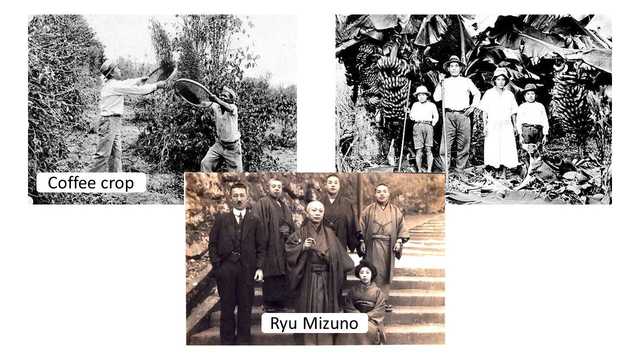 Almost all the Japanese thought that after around one year they would have enough savings to go back to Japan, but the reality was extremely tougher than that. The land was not prepared for cultivation, houses didn’t had any furniture, the weather was totally different, there were a lot of diseases totally unknown to them, and Brazilians were used to eating beans with salt. So it was a hard beginning.
This is Ryu Mizuno, known as the father of Japanese immigration. He was the responsible for proposing to the Japanese government the immigration to Brazil as a solution for the situation in Japan, after visiting Brazil and knowing better about the potential of coffee production. He was aboard the ship Kasato Maru too and his diary and a lot of his personal belongings are exposed at the Japanese Immigration Museum, in Sao Paulo.
Today it is estimated that there are more than 1 million Japanese descendants living in Brazil. Most part in Sao Paulo and Parana state, but they are also spread among all over Brazilian territory.
|
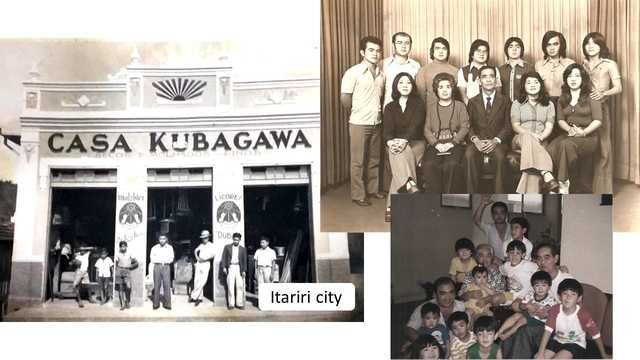 So now I will give you more details about the history of my family.
My mother’s parents were born in Nago city, Okinawa. My grandfather went to Brazil in 1936, with his four brothers and one sister. He was 18 years old at the time. He and his brothers went to a small city in Sao Paulo called Itariri. After 2 years, when my grandmother completed 18 years old, she went to Brazil in 1938 to join my grandfather. They had 12 children, but 2 passed away in the childhood. My mother didn’t met them, because she was born more than 10 years later. My mother was the 10th child.
The beginning was tough, like for every immigrant. But as the profits of the crops grow up they could get a better life. My grandfather`s brother opened a grocery shop and together with the other brothers, they bought the first truck in the city to deliver the harvests.
My mother and her brothers and sisters, could even go to the university in Sao Paulo city. So when everyone got jobs in the city, my grandparents decided to sell the crops and move to Sao Paulo. My grandfather then could return to Japan sometimes to visit the family that stayed here or returned after living in Brazil for a couple of years. My grandmother could also come to Japan one time. But only after more than 40 years after they arrived in Brazil. They lived in Sao Paulo until their death. My grandfather passed away when I was four and my grandmother when I was 17.
Here is the grocery shop.
This photo was taken in 1975, my mother was 19 years old.
|
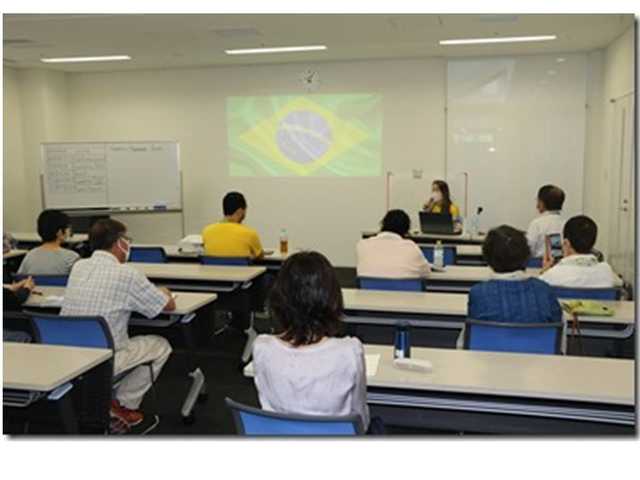 第1部終了です。
Gabrielaさんにはずっとマスクを着用して講義していただきました。お疲れさまでした。
会場は図書館交流プラザLibraで、感染対策のため入室限度はキャパシティの半分の23名でした。 |















